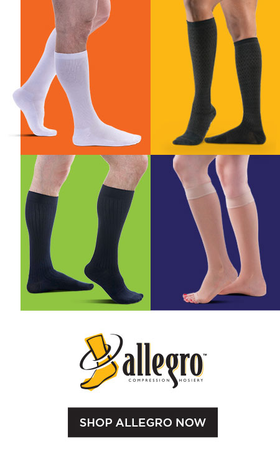While venous thromboembolism, the formation of blood clots in the veins of the legs, can occur for a variety of reasons, some common factors in their formation include surgery, a bone fracture or a prolonged period of immobility. While there were once questions as to the effectiveness of compression hosiery in reducing the risk of venous thromboembolism, particularly in post-operative situations, recent studies clearly show that quality compression hosiery can play a major role in the prevention of this condition.
Deep venous thromboembolism can be a very serious health problem. The formation of these blood clots in the legs can cause pain in the leg, while also impeding normal circulation within the leg. An even more serious problem is when such clots break loose and travel through the bloodstream, possibly reaching the lungs or other organs of the body where their effect can be extremely serious, or even deadly.
Studying the Effectiveness of Compression Hosiery in Reducing Risk
The role that compression hosiery can play in significantly reducing the risk for post-operative thromboembolism was highlighted in a Canadian meta-study conducted by researchers in Hamilton, Ontario. The researchers began by doing a review of published research articles which had examined the effects of compression hosiery in post-operative situations. The researchers identified more than 122 articles in peer-reviewed medical journals, and then did an analysis based on 11 of the broadest, strongest and most scientifically valid studies reported in these journals. These studies covered some 1752 moderate-risk patients.
What the analysis found was that the use of graduated compression hosiery in post-operative patients helped reduce the risk of venous thromboembolism by as much as 68%. While the patients studied were primarily at moderate risk due to the type of surgery they had had (mainly abdominal surgery), the analysis nevertheless found 164 cases of venous thromboembolism in the control group patients who did not use graduated compression hosiery.
However, for a similar number of patients whose treatment included the use of graduated compression hosiery, there were only 58 episodes of venous thromboembolism occurring, a clear and significant decrease in the number of cases.
Use of Compression Hosiery to Prevent Thromboemboli Increasing
In recent years, physicians have become much more aware of the preventive value of graduated compression hosiery in preventing deep vein thromboembolism. Clearly, as demonstrated by these studies, there is clear and significant benefits to the patient when compression hosiery is ordered or recommended by a physician following surgery. Of course, such hosiery is only effective when the patient uses it on an ongoing basis, as directed by his or her physician.
Of course, the use of graduated compression hosiery is not a guarantee that an episode of venous thromboembolism will not occur. There are a large variety of factors — from the type of surgery to the patient's age to other complicating health issues — that can affect the risk for venous thromboembolism that any particular individual is facing. However, as a considerable amount of research has shown, there clearly is a significant health benefit and risk reduction when it is medically determined that graduated compression hosiery should be used.


